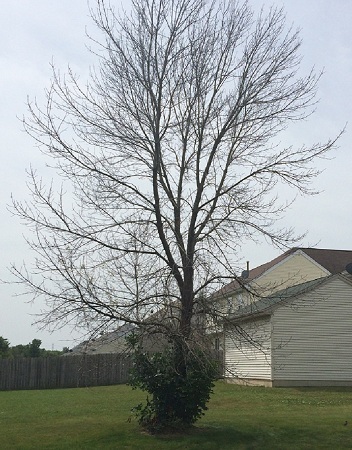
Insect & Disease
Leaf Scorch
What is Leaf Scorch?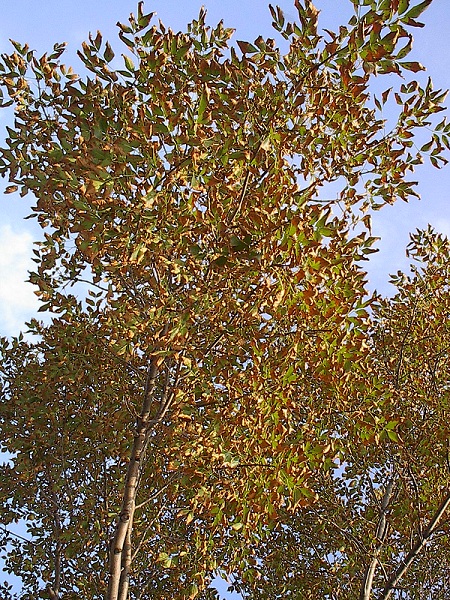
Leaf Scorch, also known as Leaf Burn, is a naturally occurring problem in trees and shrubs that is caused when sufficient water does not reach the leaves of the tree. Leaf Scorch appears as a drying out of the exterior of the leaf, often looking burned or singed. The inside of the leaf may still appear green (or the correct color depending upon the tree) at first, but as the problem continues the interior will get smaller. Leaf Scorch is often called a tree disease, however it is not caused by a fungi, although bacteria can play a role in developing a Leaf Scorch problem.
What Causes Leaf Scorch?
Leaf Scorch can be caused by a number of different things:
-
- Dry soil
- Water is lost by the tree quicker than it can be replaced
- Roots have died off because of excavation, compaction, or disease.
- Fungus or Bacteria have clogged the “arteries” (water conducting vessels called xylem) of the tree
Dry conditions and drought are prime causes for Leaf Scorch, which in the Chicago-land area are the months of July, August, and September.
What trees can get Leaf Scorch?
Almost any tree can get Leaf Scorch if weather conditions are bad enough, conditions such as low soil moisture, dry winds, and high temperatures. The trees in Illinois and Indiana that have a higher chance of a Leaf Scorch problem are:
-
- Sugar Maple
- Norway Maple
- Beech
- Ash
- Oak
- Linden
- Japanese Red Maples
- Dogwoods (growing in full sun)
Evergreens also are susceptible, such as Pine, Spruce and Hemlock.
How Do I Treat Leaf Scorch Myself?
There are a few horticultural management practices that will help trees affected with non-bacterial Leaf Scorch. When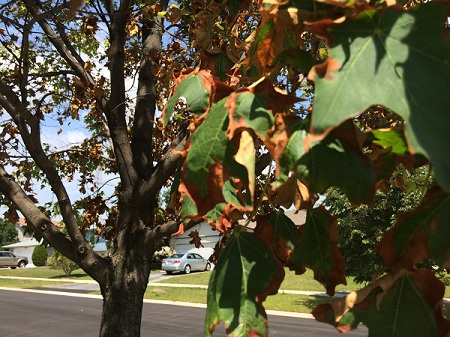 you notice a tree with Leaf Scorch, the first step property owners can take is to apply water to the tree. Also, mulching around the base of the tree with 3” of mulch will help the soil retain rain moisture and therefore help prevent the problem. However, the mulch ring should be larger (8’) than what is typical for aesthetic purposes.
you notice a tree with Leaf Scorch, the first step property owners can take is to apply water to the tree. Also, mulching around the base of the tree with 3” of mulch will help the soil retain rain moisture and therefore help prevent the problem. However, the mulch ring should be larger (8’) than what is typical for aesthetic purposes.
What Can Suburban Landscaping Do For Leaf Scorch?
Depending upon the cause of the Leaf Scorch, we can do a few different things to help your trees. We can inject water into the soil watering the deep roots. We can mulch around the base of the tree to help retain soil moisture. If the tree has Leaf Scorch because of a bacteria, we can treat inject and antibiotic into the tree. We also can apply an insecticide to help control insects that may be carrying the bacteria. Another service that we can offer which aids in the recovery of Leaf Scorch is fertilizing the tree.
Emerald Ash Borer
Emerald Ash Borer (EAB) has been an ongoing problem in the Midwest since being discovered in southeast Michigan in 2002. Since 2002, the infestation of the Midwest has spread to over 18 states (as of 2013), affecting millions of Ash trees (Genus: Fraxinus). Emerald Ash Borer (Agruius planipennis Fairmaire) is an invasive insect, originally native to Asia, Russia, and China. All 16 cultivars of Ash trees native to North America are susceptible to Emerald Ash Borer, and left untreated, all will eventually succumb to the insect.
The Emerald Ash Borer feeds on the vital layer between the bark and the trunk. This area of the tree, the Cambium, is responsible for transporting water and nutrients between the roots and the leaves of the tree. Once infested, the Ash tree will start to show symptoms in the upper canopy first, usually in the form of die-back, or dead branches. Occasionally, the tree will grow new “shoots” or sprouts from the trunk of the tree after the top starts to die. Another way to know if your tree is infested, is by the presence of 1/8 inch “D” shaped exit holes in the bark of the infested tree. The exit holes are usually found starting in early summer. In heavy infestations, the bark of infested trees may also start splitting, due to the insect’s larva feeding.
Quick Emerald Ash Borer Facts:
- Being a non-native insect, they have no known natural predators in the U.S.
- There are over 12 million Ash trees in the Chicago Region, and over 125 Million in Illinois.
- Emerald Ash Borer have already killed over 25 Million Ash Trees in the Midwest, since being discovered in 2002.
- Current available protective treatments will help.
How Long Does It Take To Kill An Ash Tree?
Usually, after infestation is noticed, the top of the tree will die off within 2 years. The remainder of the tree will usually die off within 5 years, but can die within 2-3 year
s depending upon the severity of the infestation.
What If My Neighbour Has Emerald Ash Borer?
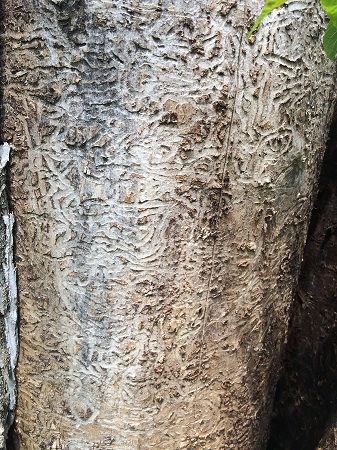
Odds are that your Ash tree will soon be infected by the borer. Adult EAB’s can fly up to ½ mile from where they are hatched. Even if your trees are healthy, they are still susceptible to EAB. Starting a preventative treatment plan for your Ash trees is highly recommended.
Emerald Ash Borer Treatments
Although a work-in-progress, the current best treatment for Emerald Ash Borer is to treat with a systemic chemical application that transfers throughout the Ash tree. Many chemical manufacturers, government agencies, and universities are working on this problem, conducting studies to find the best treatment and application times.
Cost Of Treating For Emerald Ash Borer
The cost of treating Ash trees for the Emerald Ash Borer can vary depending upon the number of Ash trees you have, and the extent of the infestation. Usually, EAB treatment starts at $125 for one tree and goes as low as $25 if you have a number of Ash trees to be treated.
Is Emerald Ash Borer Treatment Effective?
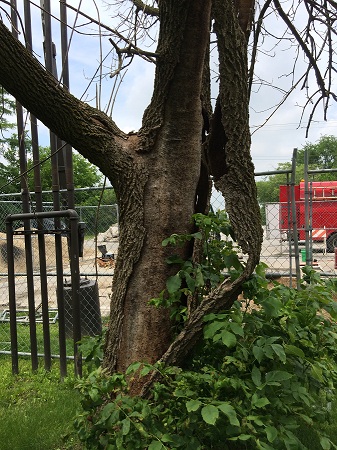
Research and field tests have shown that treatment for Emerald Ash Borer can be effective using current application techniques. However, treatment of any insect that feeds “under the bark” is a difficult task. Emerald Ash Borer is especially difficult because most North American trees do not have a natural resistance to this foreign invader. Treatment has shown to greatly extend the life of infested trees and severely slow the damage.
Do-It-Yourself Emerald Ash Borer Treatments
For Ash trees under 8" in diameter, homeowners can treat Emerald Ash Borer themselves by using the chemical imidacloprid, which can be found in Bayer Advanced Garden Tree & Shrub Insect Control. Larger trees should be let to the professionals,please contact our office for a quote.
More Information On Emerald Ash Borer
More information can be found at he following websites:
Fire Blight
What Is Fire Blight?
Fire blight is a highly damaging native pathogen for many species of plants. Being a widespread bacterial disease that is easily transferable, Fire Blight (Erwinia amylovora) can kill tree branches or entire trees. Fire Blight is usually spread in the warm (65 degrees or more) temperatures and during the humid times of year. If these temperatures are reached during the bloom cycle (spring bloom), then the chance of a Fire Blight infection increases greatly. Fire Blight can spread from an infected plant to healthy plant by rain, insects, wind, and pruning tools.
How Do I Know If I Have Fire Blight?
Initially, the disease enters the tree through openings such as flowers, and by insects, usually in the new growth. As the disease lingers, the older wood and branches will become affected. The dying new growth will die back from the tip and will usually have a deep rust color or look “burned”. One of the most telling signs your tree has Fire Blight is the ends or tips of the branches start to curl or bend, resembling a “shepherds crook”. The leaves of a plant infected by Fire Blight will start to turn a dark brown and then black. The leaves will also start to curl and wilt, but will not fall off. The leaves will usually remain on the tree all summer, and usually even after the non-affected leaves have fallen. In the spring, blossoms infected with Fire Blight will turn to a light brown color then a dark brown color. There also is typically a bacterial “ooze” that is on the diseased blossoms, fruit, stems, and often the infected trunks. This ooze, which is filled with the Fire Blight disease, can be pearl color or amber color.
Plants Affected By Fire Blight:
- Serviceberry
- Pear
- Crabapple
- Hawthorn
- Cherry
- Spirea
- Rose
Fire Blight Resistant Plants:
|
Tree: |
Resistant Cultivar: |
|
Crabapple: |
Adams, Dolgo, Jewelset (and many apple-scab resistant varieties) |
|
Pear: |
Kieffer, Magness, Moonglow, Orient |
|
Hawthorn: |
Washington |
Fire Blight Treatments:
The treatment for Fire Blight is difficult. Prevention is the best method, which is done by two spray applications of the trees in the spring.
In the summer, some control can be achieved by an injection treatment, but only about a 50% control. Summer time control is usually handled by pruning out the infected wood, 8” (crab apples) to 12” (pears) below the infection. These branches must then be burned to destroy the infection and prevent the further spread of the disease. Also, when pruning the trees, the pruning tools must be cleaned after each and every cut, using a diluted alcohol solution or a diluted bleach solution.
Because prevention is the best method, and curatives after infection are difficult, and the considerable time investment to prune the trees, many experts recommend removal and replacement with trees varieties that are resistant to Fire Blight. We only suggest this approach on a very few trees that contract the disease on a regular basis.
Do-It-Yourself Fire Blight Treatment:
We do not suggest this, but for those who insist: Do not prune the infected trees when it is wet outside, and avoid high nitrogen fertilizing of the trees., especially in the summer. If you are pruning and using a disinfectant, remember to wash and oil your loppers after you have finished your pruning. Also, do not prune the infected trees in the fall, but prune the cankers in the winter or very early spring. For chemical treatments, consult your local horticulturalist for fungicides containing copper sulfate, which need to be applied every seven days during the bloom time in the spring.
Cost Of Fire Blight Treatment:
The cost of having a professional service manage your Fire Blight depends on the service. Applying spray applications is fairly inexpensive, maybe around $60 - $90 per tree for a few trees and lower if you have many trees. Pruning of trees after a tree contracts Fire Blight can be very time consuming and expensive. Workers properly trained by a qualified Arborist or Forester are required to do the work, and this cost can be anywhere from $150 per tree to $500 per tree depending upon the number of trees and the size of the trees.
Cedar-Hawthorn Rust
Most noticeable on Hawthorn trees, this disease also infects Crabapples, Apples, and sometimes Serviceberry and Pear trees. The disease is most noticeable because of the small orange “dots” that appear on the leaves of the plants. This disease rarely kills a Hawthorn tree, but it can disfigure infected twig and branches. In order to survive, this disease actually requires two host plants to transfer between, the Hawthorn tree and the Juniper evergreen.
What Does Cedar-Hawthorn Rust Look Like?
Small orange circles will speckle the leaves after infection in the spring. As the disease matures, the circles will get larger and smaller black centers appear in the orange circle. By summer, there will be 1/8” tubes hanging from the underside of the leaves. In a severe infestation, the leaves also may turn bright yellow and fall off early.
More Detailed Information About Cedar-Hawthorn Rust
Cedar-Hawthorn rust is caused by a fungus called Gymnosporangium globosum. There are actually three kinds of Cedar-Rust, also including Cedar-Apple Rust and Cedar-Quince Rust, all of which are closely related Rust diseases.
Rust diseases have five different spores in their life cycle, with no repeating spores. Which means the disease doesn’t re-infect the same plant, or at least not for several years.
Treatment Of Cedar-Hawthorn Rust
Treatment is a preventative spring-only fungicide application that should be made before or during the bloom cycle. For an estimate to treat your Hawthorn trees for Cedar-Hawthorn Rust, please call our office or request a quote online.
Plants Susceptible To Hawthorn Rust In Chicagoland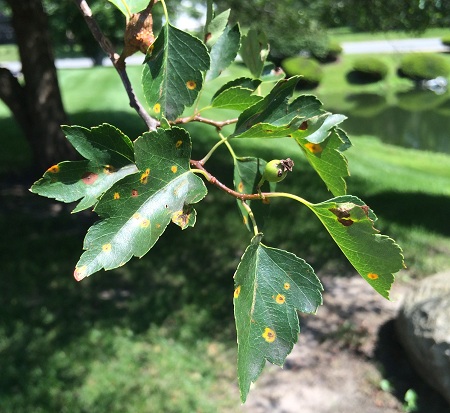
-
-
- Eastern red cedar
- Rocky Mountain Juniper
- Southern Red Cedar
- Common and prostrate junipers
- Apples
- Crabapple,
- Hawthorns
- Pear
- Quince
- Serviceberry.
-
